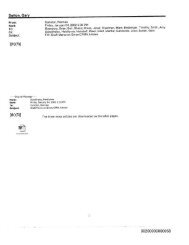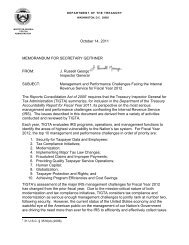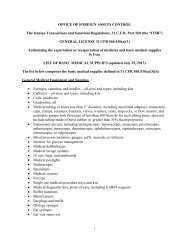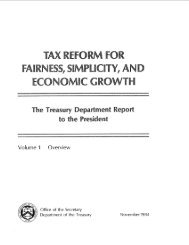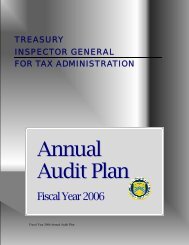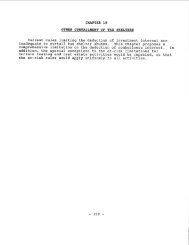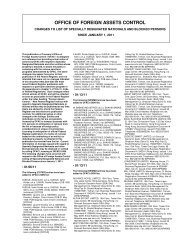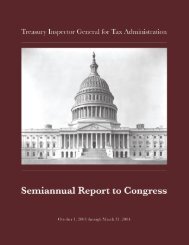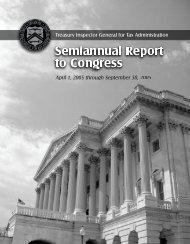Annual Audit Plan -- FY2005 - Department of the Treasury
Annual Audit Plan -- FY2005 - Department of the Treasury
Annual Audit Plan -- FY2005 - Department of the Treasury
Create successful ePaper yourself
Turn your PDF publications into a flip-book with our unique Google optimized e-Paper software.
<strong>Treasury</strong> Inspector General for Tax Administration - Office <strong>of</strong> <strong>Audit</strong><br />
address <strong>the</strong> root causes identified in <strong>the</strong> studies. Over <strong>the</strong> past two fiscal years, <strong>the</strong><br />
TIGTA has cited four primary challenges <strong>the</strong> IRS and its contractors must overcome to<br />
be successful: 1) implement planned improvements in key management processes and<br />
commit necessary resources to enable success, 2) manage <strong>the</strong> increasing complexity and<br />
risks <strong>of</strong> <strong>the</strong> BSM program, 3) maintain <strong>the</strong> continuity <strong>of</strong> strategic direction with<br />
experienced leadership, and 4) ensure PRIME contractor performance and accountability<br />
are effectively managed. Based on <strong>the</strong> results <strong>of</strong> recent audits, as well as <strong>the</strong> study<br />
findings, <strong>the</strong> TIGTA believes <strong>the</strong>se four challenges still need to be met to achieve<br />
program success.<br />
Likewise, challenges remain in <strong>the</strong> area <strong>of</strong> security even though <strong>the</strong> IRS has experienced<br />
some successes. For example, one TIGTA report 3 showed that <strong>the</strong> IRS made<br />
commendable progress in certifying its many computer systems, but additional work<br />
remains to be performed before <strong>the</strong> computer security material weakness can be<br />
downgraded. The IRS has initiated efforts to revamp <strong>the</strong> certification process by placing<br />
all <strong>of</strong> its systems into one <strong>of</strong> four categories and has established certification<br />
requirements for <strong>the</strong> General Support Systems, Major Applications, and Applications <strong>of</strong><br />
Interest. O<strong>the</strong>r Applications will be mapped to <strong>the</strong> appropriate General Support System.<br />
Ano<strong>the</strong>r report 4 discussed <strong>the</strong> Infrastructure Shared Services (ISS) architecture, which is<br />
intended to provide a secure technical infrastructure to support and enable <strong>the</strong> delivery <strong>of</strong><br />
<strong>the</strong> IRS’ modernized business systems. The ISS was <strong>the</strong> first BSM project to undergo <strong>the</strong><br />
security certification testing processes required by <strong>the</strong> Office <strong>of</strong> Management and Budget<br />
and <strong>the</strong> <strong>Department</strong> <strong>of</strong> <strong>the</strong> <strong>Treasury</strong>. Although many challenges were encountered during<br />
this process, <strong>the</strong> completion <strong>of</strong> <strong>the</strong> ISS in May 2002 was a critical step in providing<br />
opportunities for <strong>the</strong> development and deployment <strong>of</strong> all o<strong>the</strong>r BSM projects. Several<br />
security weaknesses in <strong>the</strong> ISS, however, had not been adequately addressed.<br />
Since perimeter controls are strong but can be avoided and infrastructure controls and<br />
applications security are weak, security issues remain a problem. For <strong>the</strong> last three years,<br />
TIGTA assessments have been that <strong>the</strong> security infrastructure and <strong>the</strong> applications that<br />
guard sensitive data are weak because <strong>of</strong> inadequate accountability, security awareness,<br />
and training for key security employees. The primary causes are management and<br />
operational issues, not technical ones. The IRS has focused on <strong>the</strong> technical solutions but<br />
has put little effort into management and operational concerns and does not have <strong>the</strong> right<br />
people in <strong>the</strong> right places to do <strong>the</strong> right job. The end result is that <strong>the</strong> IRS still does not<br />
have an organizational culture that places strong emphasis on <strong>the</strong> security and privacy <strong>of</strong><br />
taxpayer data.<br />
Thus, <strong>the</strong> IRS remains vulnerable, and will likely continue to be at risk throughout <strong>the</strong><br />
life <strong>of</strong> its technology modernization projects. The TIGTA will continue to assess <strong>the</strong><br />
IRS’ efforts at managing those risks. The TIGTA will also review <strong>the</strong> IRS’ computer<br />
security efforts that deal with detection and prevention activities. Overall, <strong>the</strong> FY 2005<br />
3 The Certification and Accreditation <strong>of</strong> Computer Systems Should Remain in <strong>the</strong> Computer Security<br />
Material Weakness (Reference Number 2004-20-129, dated August 9, 2004).<br />
4 Security Weaknesses in <strong>the</strong> Modernization Infrastructure Have Not Been Adequately Addressed<br />
(Reference Number 2004-20-132, dated August 12, 2004.<br />
Fiscal Year 2005 <strong>Annual</strong> <strong>Audit</strong> <strong>Plan</strong> Page 8



